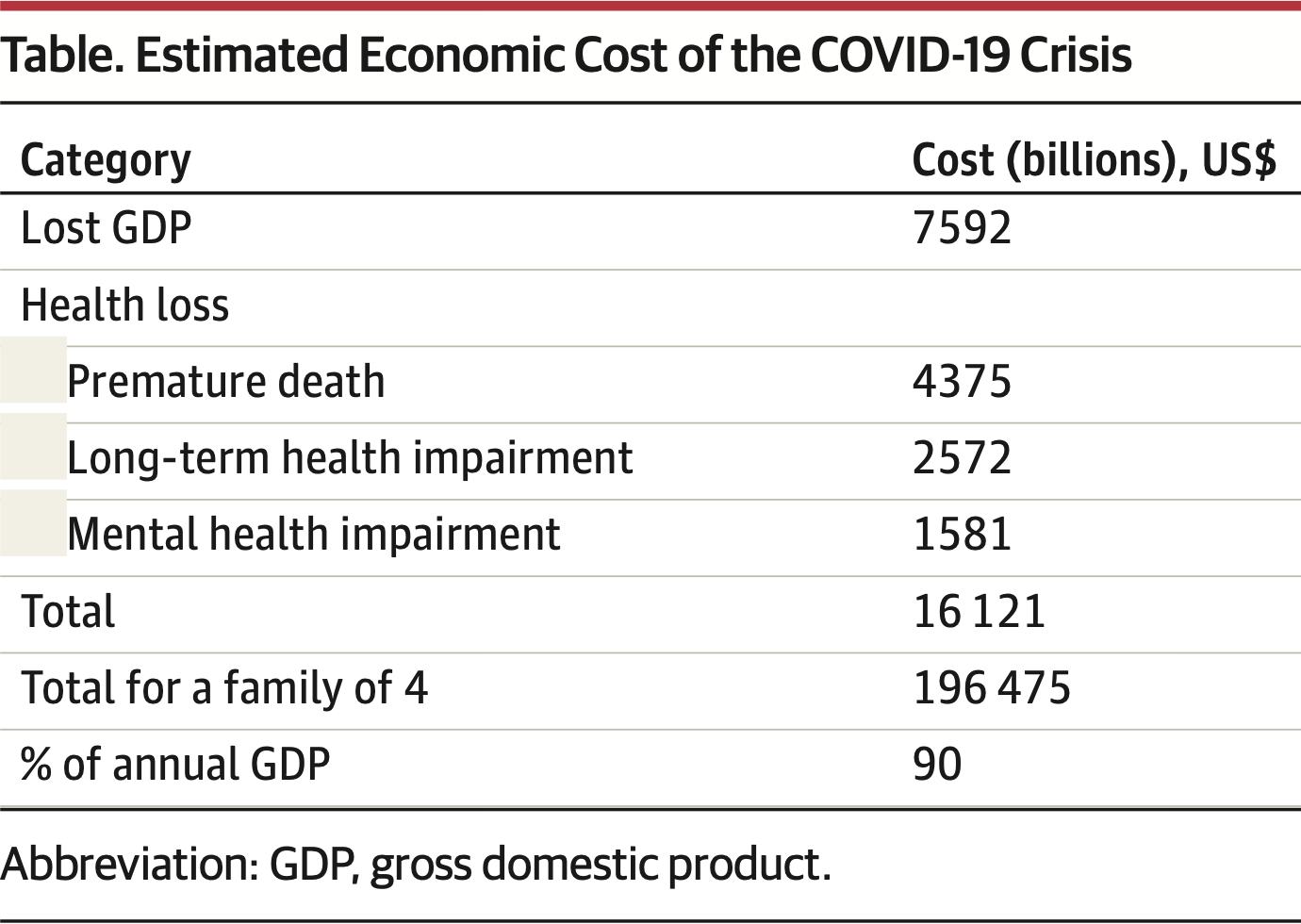
The COVID-19 Pandemic and the $16 Trillion Virus
et al., JAMA, doi:10.1001/jama.2020.19759, Oct 2020
Economic analysis estimating the total cost of the COVID-19 pandemic in the US at $16 trillion through fall 2021, equivalent to 90% of annual GDP or $200,000 per family of four.
Cutler et al., 20 Oct 2020, peer-reviewed, 2 authors.
Contact: dcutler@fas.harvard.
The COVID-19 Pandemic and the $16 Trillion Virus The SARS-CoV-2 (severe acute respiratory syndrome coronavirus 2) pandemic is the greatest threat to prosperity and well-being the US has encountered since the Great Depression. This Viewpoint aggregates mortality, morbidity, mental health conditions, and direct economic losses to estimate the total cost of the pandemic in the US on the optimistic assumption that it will be substantially contained by the fall of 2021. These costs far exceed those associated with conventional recessions and the Iraq War, and are similar to those associated with global climate change. However, increased investment in testing and contact tracing could have economic benefits that are at least 30 times greater than the estimated costs of the investment in these approaches. Since the onset of coronavirus disease 2019 (COVID-19) in March, 60 million claims have been filed for unemployment insurance. Before COVID-19, the greatest number of weekly new unemployment insurance claims (based on data from 1967 on) was 695 000 in the week of October 2, 1982. For 20 weeks beginning in late March 2020, new unemployment claims exceeded 1 million per week; as of September 20, new claims have been just below that amount.
ARTICLE INFORMATION Published Abbreviation: GDP, gross domestic product. Opinion Viewpoint
References
Ahmed, Patel, Greenwood, Long-term clinical outcomes in survivors of coronavirus outbreaks after hospitalization or ICU admission: a systematic review and meta-analysis of follow-up studies, medRxiv, doi:10.1101/2020.04.16.20067975
Bilinski, Mostashari, Salomon, Modeling contact tracing strategies for COVID-19 in the context of relaxed physical distancing measures, JAMA Netw Open, doi:10.1001/jamanetworkopen.2020.19217?utm_campaign=articlePDF%26utm_medium=articlePDFlink%26utm_source=articlePDF%26utm_content=jama.2020.19759
Crawford, United States budgetary costs and obligations of post-9/11 wars through FY2020: $6.4 trillion
Jameson, Summers, Alleyne, Global health 2035: a world converging in a generation, Lancet
Nordhaus, Projections and uncertainties about climate change in an era of minimal climate policies, Am Economic J, doi:10.1257/pol.20170046
Robinson, COVID-19 and uncertainties in the value per statistical life, Regulatory Review
DOI record:
{
"DOI": "10.1001/jama.2020.19759",
"ISSN": [
"0098-7484"
],
"URL": "http://dx.doi.org/10.1001/jama.2020.19759",
"author": [
{
"affiliation": [
{
"name": "Department of Economics, Harvard University, Cambridge, Massachusetts"
}
],
"family": "Cutler",
"given": "David M.",
"sequence": "first"
},
{
"affiliation": [
{
"name": "Harvard Kennedy School, Cambridge, Massachusetts"
}
],
"family": "Summers",
"given": "Lawrence H.",
"sequence": "additional"
}
],
"container-title": "JAMA",
"container-title-short": "JAMA",
"content-domain": {
"crossmark-restriction": false,
"domain": []
},
"created": {
"date-parts": [
[
2020,
10,
12
]
],
"date-time": "2020-10-12T19:05:53Z",
"timestamp": 1602529553000
},
"deposited": {
"date-parts": [
[
2020,
10,
20
]
],
"date-time": "2020-10-20T15:01:23Z",
"timestamp": 1603206083000
},
"indexed": {
"date-parts": [
[
2025,
8,
12
]
],
"date-time": "2025-08-12T22:00:54Z",
"timestamp": 1755036054191
},
"is-referenced-by-count": 577,
"issue": "15",
"issued": {
"date-parts": [
[
2020,
10,
20
]
]
},
"journal-issue": {
"issue": "15",
"published-print": {
"date-parts": [
[
2020,
10,
20
]
]
}
},
"language": "en",
"link": [
{
"URL": "https://jamanetwork.com/journals/jama/articlepdf/2771764/jama_cutler_2020_vp_200215_1602876140.96328.pdf",
"content-type": "unspecified",
"content-version": "vor",
"intended-application": "similarity-checking"
}
],
"member": "10",
"original-title": [],
"page": "1495",
"prefix": "10.1001",
"published": {
"date-parts": [
[
2020,
10,
20
]
]
},
"published-print": {
"date-parts": [
[
2020,
10,
20
]
]
},
"publisher": "American Medical Association (AMA)",
"reference": [
{
"DOI": "10.1016/S0140-6736(13)62105-4",
"article-title": "Global health 2035: a world converging in a generation.",
"author": "Jameson",
"doi-asserted-by": "publisher",
"first-page": "1898",
"journal-title": "Lancet",
"key": "jvp200215r2",
"volume": "382",
"year": "2013"
},
{
"author": "Ahmed",
"key": "jvp200215r4"
},
{
"article-title": "Projections and uncertainties about climate change in an era of minimal climate policies.",
"author": "Nordhaus",
"first-page": "333",
"issue": "3",
"journal-title": "Am Economic J",
"key": "jvp200215r7",
"volume": "10",
"year": "2018"
},
{
"DOI": "10.1001/jamanetworkopen.2020.19217",
"article-title": "Modeling contact tracing strategies for COVID-19 in the context of relaxed physical distancing measures.",
"author": "Bilinski",
"doi-asserted-by": "crossref",
"issue": "8",
"journal-title": "JAMA Netw Open",
"key": "jvp200215r9",
"volume": "3",
"year": "2020"
},
{
"author": "Congressional Budget Office",
"key": "jvp200215r1",
"year": "2020"
},
{
"author": "Robinson",
"key": "jvp200215r3",
"year": "2020"
},
{
"author": "Crawford",
"key": "jvp200215r6",
"year": "2019"
},
{
"author": "World Health Organization.",
"key": "jvp200215r8",
"year": "2020"
},
{
"key": "jvp200215r5",
"unstructured": "Centers for Disease Control and Prevention. Mental health: Household Pulse Survey. Accessed September 5, 2020. https://www.cdc.gov/nchs/covid19/pulse/mental-health.htm"
},
{
"key": "jvp200215r10",
"unstructured": "Rockefeller Foundation. National Covid-19 testing and tracing action plan. July 16, 2020. Accessed September 5, 2020. https://www.rockefellerfoundation.org/wp-content/uploads/2020/07/TheRockefellerFoundation_ExecutiveSummary_7_20.pdf"
}
],
"reference-count": 10,
"references-count": 10,
"relation": {},
"resource": {
"primary": {
"URL": "https://jamanetwork.com/journals/jama/fullarticle/2771764"
}
},
"score": 1,
"short-title": [],
"source": "Crossref",
"subject": [],
"subtitle": [],
"title": "The COVID-19 Pandemic and the $16 Trillion Virus",
"type": "journal-article",
"volume": "324"
}